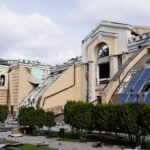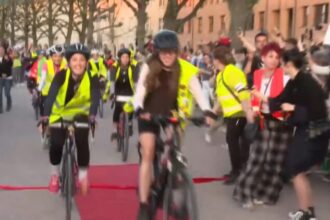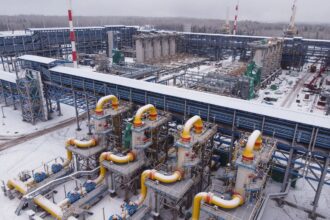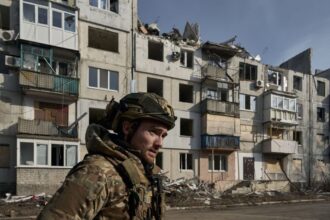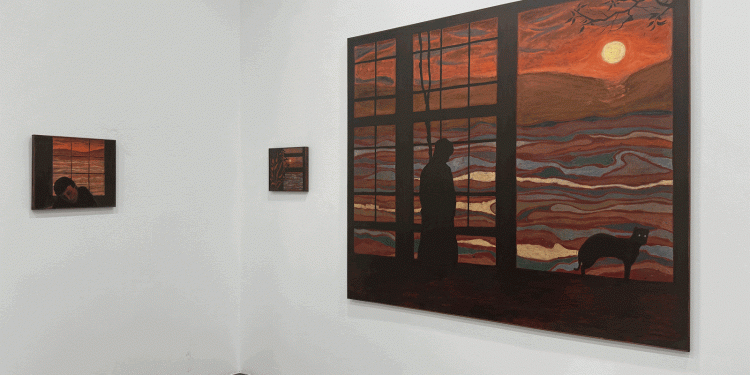The Why Not Gallery, located in the heart of Tbilisi, has curated two exhibitions which explore the depths and meanings of memory, time, and environmental consciousness. The exhibitions are strikingly different, yet equally compelling. Erekle Chinchilakashvili and Sopo Mamaladze’s Slow Sun and the artist collective Garbage Kids’ Fictionfunctionfiction present visitors with a dual journey–a contemplation of personal and collective histories, and a bold critique of modern overconsumption. These exhibitions explore both the internal landscapes and external consequences of the current socio-environmental realities, all while embracing an aesthetic that is poetic and visually arresting.
Time’s Quiet Solace
Erekle Chinchilakashvili’s paintings are like a soft glow of an evening sun suspended in moments of ethereal loneliness. His paintings explore the paradoxical nature time – constant, yet elusive; ever-present, but slipping away as we grasp it. His work is dominated by the sun, which shines with a light that is so saturated it almost overwhelms the canvas. It is a symbol of time, but also of memory – brilliant but fading and warm but distant.
Slow Sun is a series of landscapes by Chinchilakashvili that appear to be caught between reality and reverie. It’s as if you are looking back on distant memories through a window that has been blurred with sunlight. His paintings convey a quiet isolation where time seems to stretch on indefinitely but the details of a moment are already fading. His paintings invite us reflect on the fragility and fading of memory.
Chinchilakashvili has previously explored themes of memory, both individual and collective. This is evident in his solo show In a Puddle of Rust A Faded Memory Drips Budapest (2023). His multidisciplinary approach combines painting, video, and installation to explore the complexities in human perception. Slow Sun is his most contemplative work, reflecting on the passage of life with a melancholic, soft light.
Memory’s Fading Ears
Sopo mamaladze breaks the stillness of Chinchilakashvili’s quiet reflection with a burst color and energy. Her abstract compositions are vivid and visceral and capture the emotional dynamism as memory twists and changes. Mamaladze believes that memory is not a frozen image, but an ever-changing force.
Slow Sun is a collection of works by Mamaladze that evoke a visual symphony of emotion. The bold colors and fluid shapes evoke the turmoil of human experience. Her work has a raw and organic energy because her process is intuitive. She is driven by impulse, not intention. Her use of mixed mediums, including acrylics, textiles, and pastels, creates a rich, textural landscape where each stroke is imbued in sensory depth.
Mamaladze’s work is a stormy emotional recollection that is shaped by time and experience. It is the opposite of Chinchilakashvili’s sunlit stillness. It’s almost as if her abstract shapes mirror our own memories, which are sometimes vivid, sometimes blurred but always in motion. Her earlier exhibitions such as Schau in Meine Welt in Berlin demonstrated the same mastery of emotional abstract. But Slow Sun reaches new heights in dynamic intensity.
The Poetry of Waste: Reclaiming Meaning
Garbage Kids is a collective that was born out of frustration with a consumer-driven society. They take the chaos of modern overconsumption, and turn it into something deeply poetic. In Fictionfunctionfiction, their use of discarded materials–branches, stones, construction debris–becomes a powerful commentary on society’s obsession with endless growth in a world of limited resources.
Each piece in Fictionfunctionfiction has a narrative. A branch broken by a storm becomes a sculpture, a stone from an abandoned quarry finds new life as art. Each piece in Fictionfunctionfiction carries a narrative–a branch broken in a storm becomes a sculpture, a stone from an abandoned quarry finds new life in art. Garbage Kids transform the material into art that is both aesthetic and political.
Garbage Kids’ art is at the intersection of ancient wisdom with contemporary critique. They draw inspiration from premodern practices, and the everyday ingenuity that defines peasant culture. Their work is a creative response to the environmental degradation, but also a call to reconsider the value systems that are at the core of our material culture. Art asks us to rethink what we throw away and why. It also asks how these discarded items can be reimagined as something meaningful.
The Duality of Memory, Time, and Material in Art
What ties Slow Sun and Fictionfunctionfiction together is their shared exploration of time–whether through the lens of personal memory or environmental degradation. Both exhibitions invite viewers to reflect on the way we perceive time and how we engage with it, whether through the gradual fading of memories, the constant evolution in emotional experience or the unsustainable trajectory for human consumption.
Slow Sun explores the intimate and personal aspects of time. Memory is shaped both by light and emotional turmoil. Chinchilakashvili’s contemplative, serene works contrast with Mamaladze’s energetic, emotional bursts. Together, they paint a complicated picture of how we deal with the passing of time. In Fictionfunctionfiction, Garbage Kids turn their attention to the external world, critiquing the societal structures that accelerate time’s destruction through overconsumption. Their art is a reclamation time, a reject of the disposable culture which defines the present.
Together, these exhibitions in The Why Not Gallery speak of a larger cultural moment — a time when personal and collective, internal and external, are inextricably connected. Chinchilakashvili Mamaladze and Garbage Kids each invite us, in their own unique way, to pause, think, and reconsider our relationship with the world.
As the sun slowly moves across the sky we are left to reflect on the beauty of a fleeting moment, the persistence and urgency of a changing world.
By Ivan Nechaev
Read More @ georgiatoday.ge






